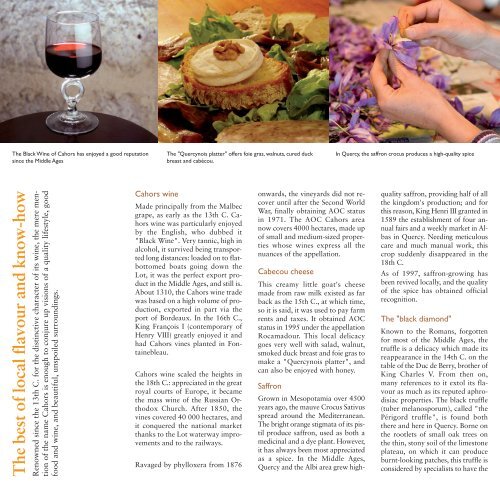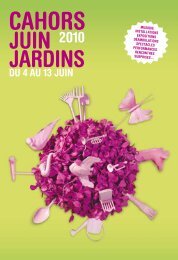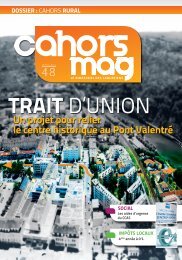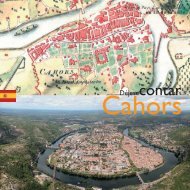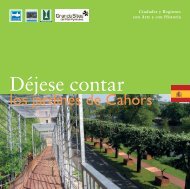You also want an ePaper? Increase the reach of your titles
YUMPU automatically turns print PDFs into web optimized ePapers that Google loves.
The Black Wine of <strong>Cahors</strong> has enjoyed a good reputationsince the Middle AgesThe "Quercynois platter" offers foie gras, walnuts, cured duckbreast and cabécou.In Quercy, the saffron crocus produces a high-quality spiceThe best of local flavour and know-howRenowned since the 13th C. for the distinctive character of its wine, the mere mentionof the name <strong>Cahors</strong> is enough <strong>to</strong> conjure up visions of a quality lifestyle, goodfood and wine, and beautiful, unspoiled surroundings.<strong>Cahors</strong> wineMade principally from the Malbecgrape, as early as the 13th C. <strong>Cahors</strong>wine was particularly enjoyedby the English, who dubbed it"Black Wine". Very tannic, high inalcohol, it survived being transportedlong distances: loaded on <strong>to</strong> flatbot<strong>to</strong>medboats going down theLot, it was the perfect export productin the Middle Ages, and still is.About 1310, the <strong>Cahors</strong> wine tradewas based on a high volume of production,exported in part via theport of Bordeaux. In the 16th C.,King François I (contemporary ofHenry VIII) greatly enjoyed it andhad <strong>Cahors</strong> vines planted in Fontainebleau.<strong>Cahors</strong> wine scaled the heights inthe 18th C.: appreciated in the greatroyal courts of Europe, it becamethe mass wine of the Russian OrthodoxChurch. After 1850, thevines covered 40 000 hectares, andit conquered the national marketthanks <strong>to</strong> the Lot waterway improvementsand <strong>to</strong> the railways.Ravaged by phylloxera from 1876onwards, the vineyards did not recoveruntil after the Second WorldWar, finally obtaining AOC statusin 1971. The AOC <strong>Cahors</strong> areanow covers 4000 hectares, made upof small and medium-sized propertieswhose wines express all thenuances of the appellation.Cabecou cheeseThis creamy little goat's cheesemade from raw milk existed as farback as the 15th C., at which time,so it is said, it was used <strong>to</strong> pay farmrents and taxes. It obtained AOCstatus in 1995 under the appellationRocamadour. This local delicacygoes very well with salad, walnut,smoked duck breast and foie gras <strong>to</strong>make a "Quercynois platter", andcan also be enjoyed with honey.SaffronGrown in Mesopotamia over 4500years ago, the mauve Crocus Sativusspread around the Mediterranean.The bright orange stigmata of its pistilproduce saffron, used as both amedicinal and a dye plant. However,it has always been most appreciatedas a spice. In the Middle Ages,Quercy and the Albi area grew highqualitysaffron, providing half of allthe kingdom's production; and forthis reason, King Henri III granted in1589 the establishment of four annualfairs and a weekly market in Albasin Quercy. Needing meticulouscare and much manual work, thiscrop suddenly disappeared in the18th C.As of 1997, saffron-growing hasbeen revived locally, and the qualityof the spice has obtained officialrecognition.The "black diamond"Known <strong>to</strong> the Romans, forgottenfor most of the Middle Ages, thetruffle is a delicacy which made itsreappearance in the 14th C. on thetable of the Duc de Berry, brother ofKing Charles V. From then on,many references <strong>to</strong> it ex<strong>to</strong>l its flavouras much as its reputed aphrodisiacproperties. The black truffle(tuber melanosporum), called "thePérigord truffle", is found boththere and here in Quercy. Borne onthe rootlets of small oak trees onthe thin, s<strong>to</strong>ny soil of the limes<strong>to</strong>neplateau, on which it can produceburnt-looking patches, this truffle isconsidered by specialists <strong>to</strong> have the


